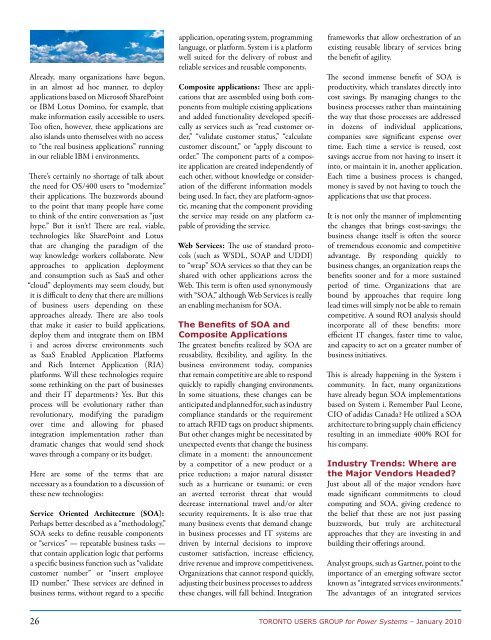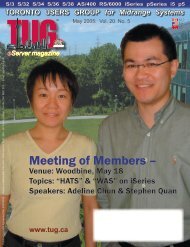Complete Magazine - PDF (5589K) - Toronto Users Group for Power ...
Complete Magazine - PDF (5589K) - Toronto Users Group for Power ...
Complete Magazine - PDF (5589K) - Toronto Users Group for Power ...
You also want an ePaper? Increase the reach of your titles
YUMPU automatically turns print PDFs into web optimized ePapers that Google loves.
Already, many organizations have begun,<br />
in an almost ad hoc manner, to deploy<br />
applications based on Microsoft SharePoint<br />
or IBM Lotus Domino, <strong>for</strong> example, that<br />
make in<strong>for</strong>mation easily accessible to users.<br />
Too often, however, these applications are<br />
also islands unto themselves with no access<br />
to “the real business applications” running<br />
in our reliable IBM i environments.<br />
There’s certainly no shortage of talk about<br />
the need <strong>for</strong> OS/400 users to “modernize”<br />
their applications. The buzzwords abound<br />
to the point that many people have come<br />
to think of the entire conversation as “just<br />
hype.” But it isn’t! There are real, viable,<br />
technologies like SharePoint and Lotus<br />
that are changing the paradigm of the<br />
way knowledge workers collaborate. New<br />
approaches to application deployment<br />
and consumption such as SaaS and other<br />
“cloud” deployments may seem cloudy, but<br />
it is difficult to deny that there are millions<br />
of business users depending on these<br />
approaches already. There are also tools<br />
that make it easier to build applications,<br />
deploy them and integrate them on IBM<br />
i and across diverse environments such<br />
as SaaS Enabled Application Plat<strong>for</strong>ms<br />
and Rich Internet Application (RIA)<br />
plat<strong>for</strong>ms. Will these technologies require<br />
some rethinking on the part of businesses<br />
and their IT departments? Yes. But this<br />
process will be evolutionary rather than<br />
revolutionary, modifying the paradigm<br />
over time and allowing <strong>for</strong> phased<br />
integration implementation rather than<br />
dramatic changes that would send shock<br />
waves through a company or its budget.<br />
Here are some of the terms that are<br />
necessary as a foundation to a discussion of<br />
these new technologies:<br />
Service Oriented Architecture (SOA):<br />
Perhaps better described as a “methodology,”<br />
SOA seeks to define reusable components<br />
or “services” — repeatable business tasks —<br />
that contain application logic that per<strong>for</strong>ms<br />
a specific business function such as “validate<br />
customer number” or “insert employee<br />
ID number.” These services are defined in<br />
business terms, without regard to a specific<br />
26<br />
application, operating system, programming<br />
language, or plat<strong>for</strong>m. System i is a plat<strong>for</strong>m<br />
well suited <strong>for</strong> the delivery of robust and<br />
reliable services and reusable components.<br />
Composite applications: These are applications<br />
that are assembled using both components<br />
from multiple existing applications<br />
and added functionality developed specifically<br />
as services such as “read customer order,”<br />
“validate customer status,” “calculate<br />
customer discount,” or “apply discount to<br />
order.” The component parts of a composite<br />
application are created independently of<br />
each other, without knowledge or consideration<br />
of the different in<strong>for</strong>mation models<br />
being used. In fact, they are plat<strong>for</strong>m-agnostic,<br />
meaning that the component providing<br />
the service may reside on any plat<strong>for</strong>m capable<br />
of providing the service.<br />
Web Services: The use of standard protocols<br />
(such as WSDL, SOAP and UDDI)<br />
to “wrap” SOA services so that they can be<br />
shared with other applications across the<br />
Web. This term is often used synonymously<br />
with “SOA,” although Web Services is really<br />
an enabling mechanism <strong>for</strong> SOA.<br />
The Benefits of SOA and<br />
Composite Applications<br />
The greatest benefits realized by SOA are<br />
reusability, flexibility, and agility. In the<br />
business environment today, companies<br />
that remain competitive are able to respond<br />
quickly to rapidly changing environments.<br />
In some situations, these changes can be<br />
anticipated and planned <strong>for</strong>, such as industry<br />
compliance standards or the requirement<br />
to attach RFID tags on product shipments.<br />
But other changes might be necessitated by<br />
unexpected events that change the business<br />
climate in a moment: the announcement<br />
by a competitor of a new product or a<br />
price reduction; a major natural disaster<br />
such as a hurricane or tsunami; or even<br />
an averted terrorist threat that would<br />
decrease international travel and/or alter<br />
security requirements. It is also true that<br />
many business events that demand change<br />
in business processes and IT systems are<br />
driven by internal decisions to improve<br />
customer satisfaction, increase efficiency,<br />
drive revenue and improve competitiveness.<br />
Organizations that cannot respond quickly,<br />
adjusting their business processes to address<br />
these changes, will fall behind. Integration<br />
frameworks that allow orchestration of an<br />
existing reusable library of services bring<br />
the benefit of agility.<br />
The second immense benefit of SOA is<br />
productivity, which translates directly into<br />
cost savings. By managing changes to the<br />
business processes rather than maintaining<br />
the way that those processes are addressed<br />
in dozens of individual applications,<br />
companies save significant expense over<br />
time. Each time a service is reused, cost<br />
savings accrue from not having to insert it<br />
into, or maintain it in, another application.<br />
Each time a business process is changed,<br />
money is saved by not having to touch the<br />
applications that use that process.<br />
It is not only the manner of implementing<br />
the changes that brings cost-savings; the<br />
business change itself is often the source<br />
of tremendous economic and competitive<br />
advantage. By responding quickly to<br />
business changes, an organization reaps the<br />
benefits sooner and <strong>for</strong> a more sustained<br />
period of time. Organizations that are<br />
bound by approaches that require long<br />
lead times will simply not be able to remain<br />
competitive. A sound ROI analysis should<br />
incorporate all of these benefits: more<br />
efficient IT changes, faster time to value,<br />
and capacity to act on a greater number of<br />
business initiatives.<br />
This is already happening in the System i<br />
community. In fact, many organizations<br />
have already begun SOA implementations<br />
based on System i. Remember Paul Leone,<br />
CIO of adidas Canada? He utilized a SOA<br />
architecture to bring supply chain efficiency<br />
resulting in an immediate 400% ROI <strong>for</strong><br />
his company.<br />
Industry Trends: Where are<br />
the Major Vendors Headed?<br />
Just about all of the major vendors have<br />
made significant commitments to cloud<br />
computing and SOA, giving credence to<br />
the belief that these are not just passing<br />
buzzwords, but truly are architectural<br />
approaches that they are investing in and<br />
building their offerings around.<br />
Analyst groups, such as Gartner, point to the<br />
importance of an emerging software sector<br />
known as “integrated services environments.”<br />
The advantages of an integrated services<br />
TORONTO USERS GROUP <strong>for</strong> <strong>Power</strong> Systems – January 2010





